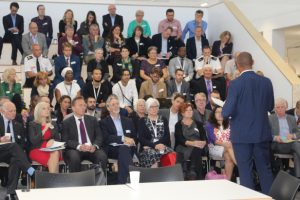Tessa Coombes, PhD student in the School for Policy Studies, former councillor, ex-policy director at Business West, and part-time blogger considers the new plans for the City office and the impact this will have on the way Bristol is governed and the people who govern it.

There’s a new approach to partnership working being proposed in Bristol.
Living as we do in the most centralised state in the western world, many different approaches have been taken over the years to try and break down barriers, grab additional local power and move away from the silo thinking that dominates our political and administrative systems. However, few of these have managed to make any significant difference to policy and decision making at a sub national and local level.
Recent years have seen more debate about devolution, leadership and collaborative governance. This has manifested itself in discussions around ‘place-based leadership and power’ where different ways of working are being identified to address the challenges faced by localities. There’s also been a change to the way some cities are governed, with the introduction of directly elected mayors providing clear, accountable local leadership with enhanced powers.
Robin Hambleton in his book “Leading the Inclusive City” (2015) sets a conceptual framework that identifies five intersecting realms of leadership: political leadership, public managerial/professional leadership, trade union leadership, business leadership, and community leadership. He suggests that where these realms overlap we create innovation zones where more creative and inventive behaviour takes place, particularly where it can be focused on aspects of unified action.
It is this very concept that is about to be tried in Bristol through the creation of a City Office. It’s an idea that seeks to address some of the challenges faced by the public sector, with ever decreasing budgets and reducing powers. It is about partnership and collaborative governance, bringing organisations, individuals and budgets together to tackle the issues that we have failed to tackle before, where collaboration and joint working are essential, alongside the willingness to be creative and innovative.
Whilst there have been many partnerships developed over the years in Bristol, some that have worked, others that have been less successful, somehow this new partnership feels different. Perhaps the increasingly challenging context for change is one reason why it feels different this time. With a new form of governance in the city, a directly elected mayor who can lead with greater power and greater visibility, maybe there is now the direction and clarity the city has needed to make this work.
There is also the ‘shadow of austerity’ across the whole of the public sector and local government in particular. The council in Bristol once again faces severe cuts that mean its ability to do anything beyond deliver on statutory services is significantly reduced. That in itself is a big restraint, when you are facing big problems in the city that cannot be solved without significant time, effort and resource. Yet, there is a history of partnership working in the city that has successfully delivered change, with business, public and voluntary/community sectors coming together to make things happen.
Bringing these elements together, in a new partnership approach, could provide the impetus needed to make a difference.
The idea is to enable the city to develop solutions to the issue that matter most, issues that to date we have failed to adequately address. It is also about learning, experimenting and innovating, about not being too afraid of failure and being brave enough to take risks in order to find that set of solutions that do work. The city office is unique in its aim of changing the way we do things, by working together and applying collective resources to the challenges we face, by taking a truly ‘total place’ approach to city development.
It will operate at both a strategic and tactical level, bringing organisations together on project activities that deliver in the short and medium term as well as focusing on creating a shared vision for the future. The concept of additionally is critical, all the projects and activity of the city office need to bring with them the ability to provide something extra as a result of working together.
In addition to the project activity, the Mayor introduced the idea of a ‘Single Plan for Bristol‘, a strategic level shared vision for the future of the city, in a similar vein to the OneNYC Plan. A bold idea that has the potential to really make a difference to the key challenges we face as a city. This is where the city office can bring people and organisations together to work collaboratively to set out a long-term simple but ambitious vision with measurable and achievable short and medium term targets. It should be about addressing the root causes of problems and providing sustainable solutions, and not ducking the difficult issues. It is also where we can set out how we address the ‘big’ issues, like how we eradicate inequality and poverty in our city, providing something that everyone should be able to sign up to.
There’s a long way to go on developing the city office and this new approach to ‘place-based leadership’ but so far the signs are positive and the potential is definitely there to influence and create change.


